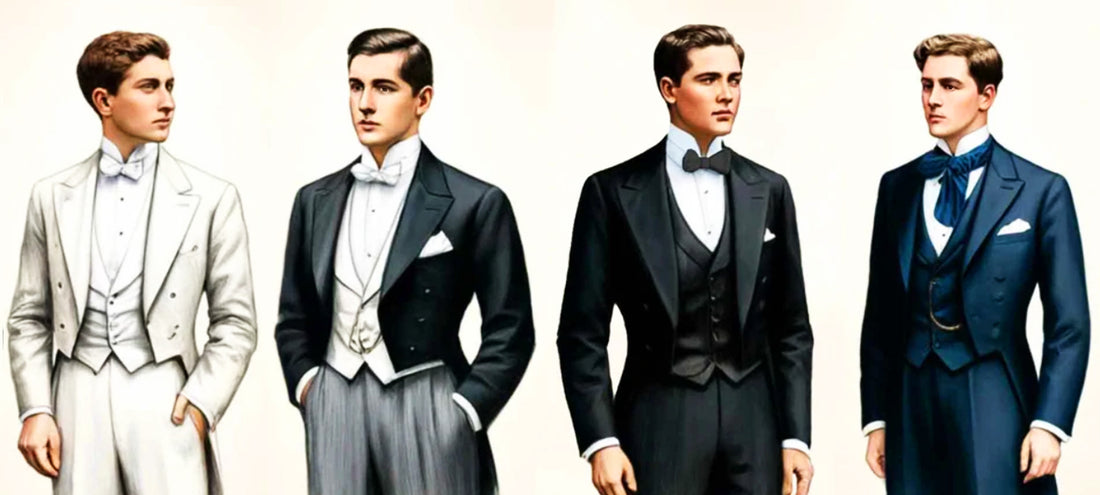
How/When/Why Formal Wear?
Share
Opinions - Editorial by Jacques Hermes
Estimated reading time 3 minutes
Import
Dressing in formal attire has a long and rich history. This method seems to have its roots in ancient times, but its modern version dates back to the era of the royal courts of Europe. At that time, the choice of attire was a method of declaring social status and prestige - a status symbol and followed specific protocols that provided for specific colors, materials and designs for each occasion. In contrast to the institution of monarchy, which weakened significantly in the following centuries, this framework was maintained, evolved and is still applied today by a large percentage of the world's population, whether knowingly or unknowingly. This article will discuss the history of these protocols, the rules they consist of and how they can be applied in combination with the personalized clothing services provided by Jacques Hermes.

Historical Review
Over a wide span of time spanning from antiquity to the modern world, formal garments were/are chosen as symbols of prestige and respect. Their form varied and constantly changed depending on society and time. The latest and most widely accepted such variation is the suit, versions of which are chosen today in a multitude of places and circumstances.
The great and timeless success of the garment led to many individual innovations in shades, seams and applications in order to meet the various needs of use. In terms of colors, the most basic choices that were formed are white, black and blue.
White tie : Historically, the use of white clothing dates back to the 19th century, when dancing and large social events were a central part of aristocratic social life.¹ This shade was a staple of royal and aristocratic families and thus became established as the most formal form of men's attire. As such, it is reserved for high-status events (such as royal balls and dinners).
Black tie : It became popular in the 20th century as a more practical-simple option for the same occasions. Today it is widely used, among other things, at evening events and cocktail parties.
Blue tie : They also began to appear in the mid-20th century, offering a -less established- alternative for more discreet but elegant appearances. They continue to be the most common choice today and are used in occasions that require discreet elegance without the rigor of white or black clothing.


How/When/Why Formal Wear?
The rich and interesting history of formal wear has, over time, formed some unwritten rules for its use depending on the circumstances. This framework, which concerns every person who wants to choose formal attire for their outings, will be defined and verified below. Simply put, we will attempt to answer the questions: " how ", " when " and " why " formal wear?
How
The way in which a formal garment is selected must pay due attention to detail and fit. As will be explained in the next section, in addition to the above fundamental factors, shade also plays an important role.
A white tuxedo, for example, has high demands on the quality of fabrics and stitching, while its use is accompanied by strict rules, such as choosing the appropriate shoes and accessories.
In black looks, there is more flexibility in choices, with quality and fit remaining critical.
Blue garments excel in terms of adaptability, but the basic principles of elegance and harmony in the ensemble must also be observed.
When
Generally, formal wear is used in occasions that require a high level of formality. There is a gradation of importance and prestige among these events, so the corresponding shade should be chosen accordingly. The main and most established colors are: blue, black and white.
Blue shades can be worn to high-level business meetings and events where a discreet yet elegant look is required.
Black colors are ideal for weddings, formal dinners, dances and award ceremonies as well as evening events such as cocktail parties.
White clothing can be used in some cases instead of black (formal dinners, weddings, various ceremonies) but, as a statement of the utmost formality, it is usually chosen for events of top importance such as royal balls⁴.
Why
The choice of formal attire seems to provide multiple benefits, both on a personal and social level. The main ones can be divided into the following categories.
First, choosing such attire is usually interpreted as the most appropriate and is an act of respect towards the hosts and other attendees. Such a move can easily strengthen social and professional relationships⁵.
Furthermore, the impact on the psychology of the person wearing these clothes is also significant, as it enhances self-confidence and a sense of comfort. These favorable feelings may make the difference when it comes to performing under pressure in various important situations⁶.
Finally, the combination of the above creates a pleasant image for observers and positively influences their perception of the individual. The acceptance and sympathy of the environment can prove decisive for professional success⁷. This is confirmed by recent research that concludes that people who wear formal clothes are evaluated as more competent and trustworthy by their interlocutors⁸.
Jacques Hermes: Your choice for formal and casual wear

In this context, Jacques Hermes offers a refined collection of formal and casual clothing, tailored to your needs. Whether you prefer ready-to-wear garments or tailored to your own measurements, it combines quality with elegance to highlight your personal style. With exceptional attention to detail and the selection of the best materials, we guarantee that each piece will make you stand out on every occasion. Visit us today and discover the haute couture experience we offer.
Sources
- Turner, J. (2019). The Evolution of Formal Wear in European Courts. Journal of Historical Fashion Studies, 22(3), ch. 2.
- Evans, M. (2020). Black Tie: The Cultural Significance of Formal Evening Wear. European Journal of Cultural Studies, 18(1), ch. 4.
- Harper, S. (2021). Blue Tie Events: An Analysis of Modern Formal Dress Codes. Fashion and Society, 15(2), ch. 5.
- Johnson, K. (2023). The Role of Formal Wear in Modern Society. Journal of Social Fashion Studies, 12(4), ch. 3.
- Brown, A. (2023). Event-Specific Attire: A Sociological Perspective. Journal of Cultural Sociology, 15(2), ch. 2.
- Smith, J. (2023). The Psychology of Dress Codes. Journal of Social Fashion Studies, 22(1), ch. 5.
- Evans, M. (2023). The Impact of Attire on Professional Interactions. Journal of Business Etiquette, 18(3), ch. 6.
- Harper, S. (2023). Formal Wear and Social Perceptions. Fashion and Society, 17(1), ch. 4.


